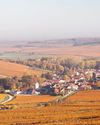Traditionally known for its good-value rustic red blends, this Languedoc heartland region is forging a new reputation for quality and great terroirs. James Lawther MW heads south for a visit.

IT’S THE SIZE and rugged beauty that assails you. Corbières is such a massive chunk of land and within its borders the terrain is so wild and resplendent. Rocky garrigue harbours bush-trained and trellised vines as well as pine, cherry, almond and olive trees, with fir and oak in the higher reaches. Some of the hillside vineyards seem incredibly remote, yet the major cities of Carcassonne and Narbonne to the north and Perpignan to the south are never far away, with the beach resorts of the Mediterranean adjacent to the east.
Viticulture has always been the mainstay of the region. When I first visited in 1997 there were just over 14,000ha of AP Corbières declared, producing an average 600,000hl, the equivalent of 80 million bottles. These days the figure stands at 10,600ha with an output of 390,000hl or 52m bottles, but it is still the Languedoc’s leading appellation by volume.
Given the size, there’s an inevitable contrast in terroirs. Soils are predominantly limestone-clay but there are zones of schist and sandstone, and enough variability to interest students of pedology. The climate is Mediterranean, but dependent on the proximity to the sea, altitude (50-500m), exposure and varying rain pattern – not to mention the passage of the humid sea wind, the Marin, or the dry northwesterly Cers – so the ripening varies, as does the quality and character of the wines.
This story is from the February 2019 edition of Decanter.
Start your 7-day Magzter GOLD free trial to access thousands of curated premium stories, and 9,000+ magazines and newspapers.
Already a subscriber ? Sign In
This story is from the February 2019 edition of Decanter.
Start your 7-day Magzter GOLD free trial to access thousands of curated premium stories, and 9,000+ magazines and newspapers.
Already a subscriber? Sign In

Wine lover's guide to ALSACE
Pretty postcard villages, delicious food, fascinating history and, of course, excellent wines - this beautiful northeastern corner of France has everything a wine lover could ask for

José Pizarro does Christmas Spanish style
In a Decanter exclusive, the celebrated chef offers up an alternative menu for the seasonal celebration

Perfect whiskies for wine lovers at Christmas
What better gift could there be for a wine and whisky lover than a whisky matured in barrels previously used for wine? Our selection of 12 great bottles shows just why it can be a match made in heaven

WHITE CHATEAU
Hitherto a bit-part player, the white wines of this celebrated southern Rhône region are well placed to find themselves increasingly in the spotlight, as a result of the changing climate conditions. Our Rhône expert recommends 20 of his favourite examples to seek out

Chablis 2023
Variable weather made it challenging at times, but a late hot spell came to the rescue, resulting in plenty of good wines for drinking and for keeping. Having tasted almost 400 Chablis 2023 wines, our expert selects 30 of his favourites, along with five from top producers in neighbouring crus

Looking BACK, looking AHEAD
As 2024 draws to a close, we asked eight of our regular contributors to nominate their most memorable wine experiences of the year and to reveal what they're anticipating most in their plans for 2025

25 TOP SYRAH/SHIRAZ REDS
Two names, a multitude of personalities. For almost two centuries, Syrah has been woven into the fabric of the southern hemisphere's wine world. Today, it makes some of the most exciting and terroir-expressive wines to be found south of equator, with a growing shift towards single-site bottlings

A Resource for the World? - Argentina is unique in the genetic diversity preserved in much of its vine material. With climate change and disease posing increasing threats worldwide, Catena Zapata winery is asking what lessons can be learned to protect vineyards within and beyond the nation's borders
Argentina is unique in the genetic diversity preserved in much of its vine material. With climate change and disease posing increasing threats worldwide, Catena Zapata winery is asking what lessons can be learned to protect vineyards within and beyond the nation’s borders

Great Cabernets of South America
Other varieties may hog the limelight across South America, but the world’s most popular grape for red wines has played a critical role in the continent's wine heritage. We trace Cabernet Sauvignon’s story here, and recommend 16 benchmark wines to try

PROVENCE by train and bike
With rail links to Paris, Nice, Marseilles and beyond, a vast network of cycle paths and quiet roads, and a plethora of historic wine estates, Provence is an ideal destination for an eco-friendly, car-free and carefree) holiday